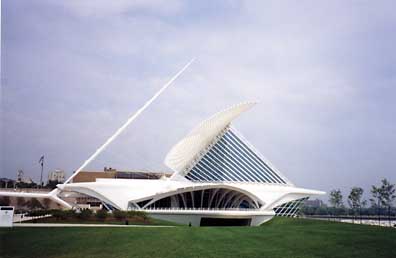

by Robert McCray
On the Dave Letterman show, Roger Clemens named the ten top things he learned in baseball. Number eight was: "There ain’t nothing to do in Milwaukee." Not exactly! Everyone is heading over to the spectacular new Milwaukee Art Museum Addition, designed by Santiago Calatrava.The building (a moving architecture with "wings") which literally soars from the shoreline – part wave, part boat, part bird — was the winner of the "Best Design of 2001 Award" by Time Magazine, and as one of the ‘Seven Wonders of the Midwest,’ tripled attendance.
Santiago Calatrava (architect, engineer, and sculptor) enjoys moving sculpture, and designed the building to contribute to the lakefront "culture."
This 100-million dollar Quadracci Pavilion Addition, on Lake Michigan’s shoreline, is a "moving" work of art in more ways than one. At noon, visitors stream out on the suspension bridge to marvel as the huge "wings" (a moveable sunscreen) close down over the building — like a giant sea bird landing on the lakeshore. This Brise Soleil (which controls light and temperature) spreads its wings in the morning, "flaps" at noon, and closes at day’s end.
The expansion added 30 percent more gallery space, fountains, and a stunning garden.
Inside, a cylindrical, glass elevator beams visitors up spaceship-style to an awe-inspiring view of the majestic parabolic-shaped, glass-walled Reception Hall, offering a Jonah-in-the-whale perspective of lake and sky.
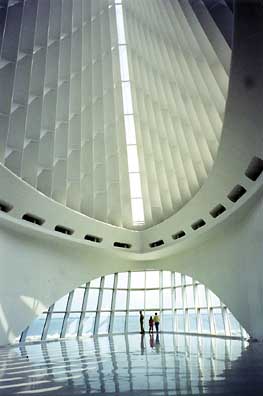
The Reception Hall in the new addition captivates visitors.
Among the museum’s more unique attractions is the American Folk and Self-taught Art collection. Margaret Andera, curator of the Milwaukee Art Museum (MAM), points out, "These galleries are made up of our entire collection of folk, self-taught and outsider art. Our collection of folk art actually dates back to 1950. Unlike most of the rest of the museum, these galleries are arranged thematically, not chronologically, because most of the artists included in these galleries were not working within or reacting to art historical movements or styles. This material was particularly well suited to thematic groupings. Much of the material on view is from the Hall collection." (MAM acquired the 273-work Hall Collection in 1989.)
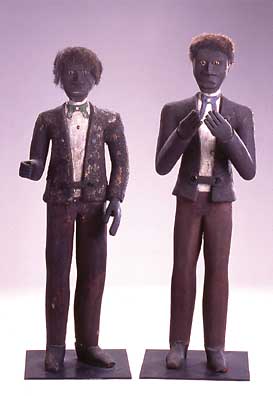
Other notable works in the Hall Collection include Preening Black Duck (1910) by A. Elmer Crowell. Duck decoys fashioned by Native Americans date as far back as 200 A.D. European settlers passed on the tradition to nineteenth century hunters, and when hunting became more sport than subsistence (and later when plastic took over), duck carving evolved to include works of art.
These days, duck carving processes include roughing out, sculpting feathers, undercutting, and more recently, burning in the feathers. (A typical feather may have 90 to 100 lines burned in per inch.) In the early days, the jackknife was the state-of-the-art carving tool.
Crowell (1862-1952), known as one of the world’s best decoy carvers, also carved shorebirds, miniatures, and ornamentals. One of his Canadian Geese recently sold at auction for nearly $700,000. Growing up in Massachusetts, as a young man Crowell hunted and carved hunting decoys. Later he worked as manager of a hunting camp and cranberry farmer, but at age 50 he turned to carving for a living. Preening Black Duck, was carved from cedar and pine, and finished with paint and glass eyes. Curator Andera says, "It’s the work I use to talk about the decoys as sculptural forms, in order to get people past simply focusing on the function of these objects. The Preening Black Duck also has a strong presence because of its elegant form and striking painted surface." It was one of Crowell’s most graceful and successful forms, with enough carved primary and tail feathers, so as not to detract from the sculpture, and a marvelous blending of paint on the head.
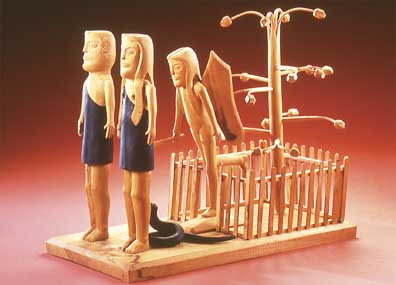
Edgar Tolson Barring of the Gates of Paradise (1970)
Edgar Tolson (1904-1984), a more contemporary folk artist, grew up in the Appalachian tradition, whittling everything from animals to walking canes and dancing dolls. He was the son of a farmer and minister, and educated through the sixth grade. In the hardscrabble world of impoverished Wolfe County, fashioning homemade tools and implements was part of everyday life, and as a jack-of-all-trades, Tolson soon mastered woodcraft, building, and carving, turning out everything from chairs, ax handles, and gravestones to lawn ornaments. After a stroke in 1957, carving, in part as therapy, became central to his life, evolving to include themes from his religious roots as well as political subjects. Despite a life of poverty, ill health, and the responsibilities of 18 children (he was married twice), his persistence, and the help of ardent supporters, including sculptor and art professor Michael Hall, resulted in growing recognition. His Fall of Man series, depicting Genesis from Adam and Eve in Paradise through Cain’s departure, is frequently cited as his breakout transition from craftsman to artist. Andera says, "The amazing thing to me about the Tolson’s carvings, especially the Fall of Man series, is how much is conveyed in them through such an economy of form. The very complex biblical story is told through these very simple, skillfully carved figures. Tolson wisely lets the story tell itself and doesn’t introduce a lot of details to distract from the story. The result is an extremely elegant and effective work of art. Certainly Tolson’s Fall of Man series is one of the most popular, because most people are familiar with the story and the presentation of the work as a group on the wall is visually stunning." Eventually he became Kentucky’s most famous wood carver, in his later years receiving wide recognition including a visual arts fellowship from the National Endowment for the Arts in 1981, and representation in national and international exhibitions, such as the Whitney Museum’s 1973 Biennial Exhibition of Contemporary Fine Art.
It has been said that Tolson was influenced by his supporters and admirers. Many of his earlier carvings, such as Man with a Pony (1958), which exemplifies his plain, direct style, were painted. But museum administrators and others encouraged him to return to a natural, unpainted finish, which he did. The Milwaukee museum holds twenty of his marvelous pieces.
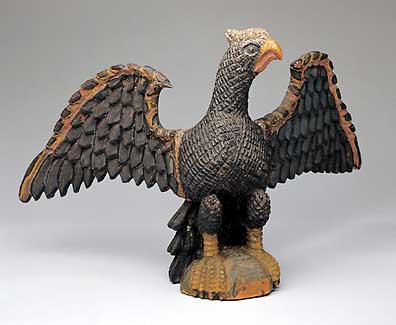
The museum also spotlights Midwest artists. Featured exhibits include a display of the remarkably unique furniture of Frank Lloyd Wright.
Wisconsin Landscape painter Tom Uttech has canoed, camped, and painted the North Woods — Wisconsin, Minnesota, and the Boundary Waters. His artistic epiphany took place in the Quatico, and ever since his paintings have captured the spirit of the North Woods in a somewhat surrealistic and mythic portrayal of the wilderness — sky, earth, creatures, and water. Uttech paints not from drawings and study, but by wilderness immersion, as he says, "fed by the natural world." A birder and environmentalist, his paintings will be exhibited July 10-September 6, 2004.
Dale Chihuly’s dazzling glass sculpture, Chandelier, in the Reception Hall, is a shutter-snapping favorite. Chilhuly received his MS from the University of Wisconsin, under Harvey Littleton, founder of the American studio glass movement.
Georgia O’Keefe was born in Sun Prairie, Wisconsin. The new gallery of her work is the largest east of New Mexico.
The original museum building, by Eero Saarinem and David Kahler, holds the permanent collection galleries, displaying 20,000 works of art from antiquity to the present, including the Old Masters and 19th and 20th-century art. The German Expressionism collection is just one of the nationally renowned exhibits. Renoir’s La Grenouillera (1870) is a recent acquisition. Galleries are arranged chronologically, so visitors can move from room to room with a sense of time and place.
The Bradley Collection of Modern Art, on the third floor of the original building, with wall-to-wall windows overlooking Lake Michigan, includes Picasso’s "Bouquet," Joan Miro’s "Rooster," and Jacques Lipshutz "Seated Bather," enhanced by natural light.
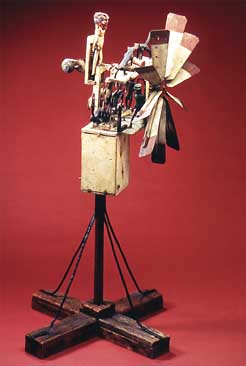
Unknown American Artist, Windmill Construction
65" x 28" x 24" est., (Painted wood, and metal)
MILWAUKEE ART MUSEUM
700 North Art Museum Drive
Milwaukee, Wisconsin 53200
(414) 224-3220
http://www.mam.org